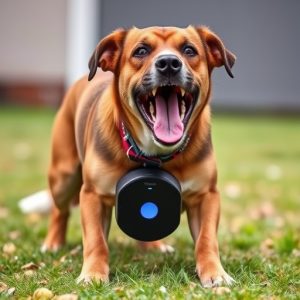Portable vs Stationary: Ultimate Guide to Dog Repellent Ultrasonic Devices
The Stationary Vs Mobile Dog Repellent Comparison explores two dog behavior management approaches. S…….
The Stationary Vs Mobile Dog Repellent Comparison explores two dog behavior management approaches. Stationary devices, installed in specific areas, use consistent signals for yard training. Portable ultrasonic equipment, on the other hand, emits high-frequency sounds for versatile, dynamic training scenarios and travel. Recent trends favor portable equipment due to its convenience and adaptability, making it ideal for outdoor sessions and new locations. While stationary solutions offer consistent protection, mobile repellents excel in flexibility and intensity customization, perfect for temporary or dynamic spaces like patios and vehicles. This comparison guides users in choosing based on unique needs.
“Unleash a new approach to dog training with portable ultrasonic equipment, a game-changer in pet care. This comprehensive guide, ‘Understanding Dog Repellent Equipment,’ explores innovative solutions for behavior modification. We delve into the rise of portable ultrasonic devices, offering a convenient, effective alternative to traditional stationary repellents. Learn about the benefits and drawbacks of each type in our Stationary Vs Mobile dog repellent comparison, helping you make an informed choice for your furry friend’s training.”
- Understanding Dog Repellent Equipment: A Comprehensive Overview
- The Rise of Portable Ultrasonic Devices for Dog Training
- Stationary vs Mobile: Pros and Cons of Each Repellent Type
- Making an Informed Choice: Factors to Consider for Effective Dog Training
Understanding Dog Repellent Equipment: A Comprehensive Overview
Dog repellent equipment has evolved significantly, offering both stationary and mobile solutions for training and behavior management. When considering the stationary vs mobile dog repellent comparison, understanding each option’s unique features is essential. Stationary devices are typically installed in specific areas to create a defined boundary, using sounds or scents to deter dogs from entering. These are often effective for yard training and can be consistent in their signal delivery.
On the other hand, portable dog training ultrasonic equipment provides versatility and convenience. These mobile devices emit high-frequency sound waves that are inaudible to humans but irritating to dogs, encouraging them to avoid certain areas. Their portability allows for dynamic training, adapting to different environments and situations, making them ideal for travel or managing specific behaviors on the go.
The Rise of Portable Ultrasonic Devices for Dog Training
In recent years, there’s been a noticeable shift in pet training methods with the advent of portable ultrasonic equipment. These innovative devices offer a modern approach to dog training, providing an effective alternative to traditional stationary repellents. The portability aspect brings a new level of convenience and flexibility for pet owners who are always on the move. Unlike their fixed counterparts, mobile ultrasonic dog repellents can be easily transported and adjusted according to various environments, making them ideal for outdoor training sessions or when visiting new places with your furry friend.
When comparing stationary vs mobile dog repellent solutions, portability stands out as a significant advantage. The ability to move these ultrasonic devices allows for a more dynamic training experience, catering to different scenarios without compromising effectiveness. This versatility has sparked interest among dog owners who seek efficient and adaptable training tools, contributing to the growing popularity of portable ultrasonic equipment in the pet training market.
Stationary vs Mobile: Pros and Cons of Each Repellent Type
In the ongoing debate between stationary and mobile dog repellents, each has its unique advantages and drawbacks. Stationary devices are typically more powerful and consistent in their ultrasonic emission, making them ideal for large areas or specific spots where dogs frequently trespass. They offer a constant, subtle deterrent that can be effective over time without any battery concerns. However, they lack mobility, rendering them impractical for areas that change frequently or require shifting coverage, such as different rooms within a house or outdoor spaces with variable weather conditions.
On the other hand, mobile dog repellents provide flexibility and versatility. They are easily transportable, allowing users to move them from place to place as needed. This makes them suitable for temporary solutions or areas with frequent rearrangements like patios, gardens, or even vehicles. Yet, their portability also means they may not emit ultrasonic signals with the same intensity or consistency as stationary models, and they might require more frequent battery replacement or charging. A Stationary Vs Mobile Dog Repellent Comparison reveals these contrasting pros and cons, guiding users to make informed decisions based on their specific requirements.
Making an Informed Choice: Factors to Consider for Effective Dog Training
When considering portable dog training ultrasonic equipment, it’s crucial to weigh the advantages of mobile, hands-free training over traditional stationary methods. One key factor is convenience; portable devices allow for flexibility in training sessions, enabling you to work with your dog in various settings, be it at home or on the go. This mobility is a significant advantage over stationary repellents, which are limited to one specific location.
Additionally, portability offers versatility in terms of intensity and frequency. Modern ultrasonic equipment often includes adjustable settings, allowing you to customize the noise level based on your dog’s sensitivity and training needs. When comparing stationary vs. mobile dog repelants, consider the potential for quieter, more subtle training aids that can be easily transported without causing disruption.
In the realm of dog training, portable ultrasonic equipment offers a modern and effective approach. This innovative technology provides pet owners with a convenient solution for managing unwanted behaviors. When comparing stationary and mobile options, each has its advantages and drawbacks. Ultimately, the choice depends on individual needs, lifestyle, and the specific challenges faced in training their canine companions. By carefully considering factors like environment, consistency of use, and the dog’s temperament, owners can make an informed decision to ensure successful and positive training outcomes using either stationary or portable ultrasonic repellent equipment.


